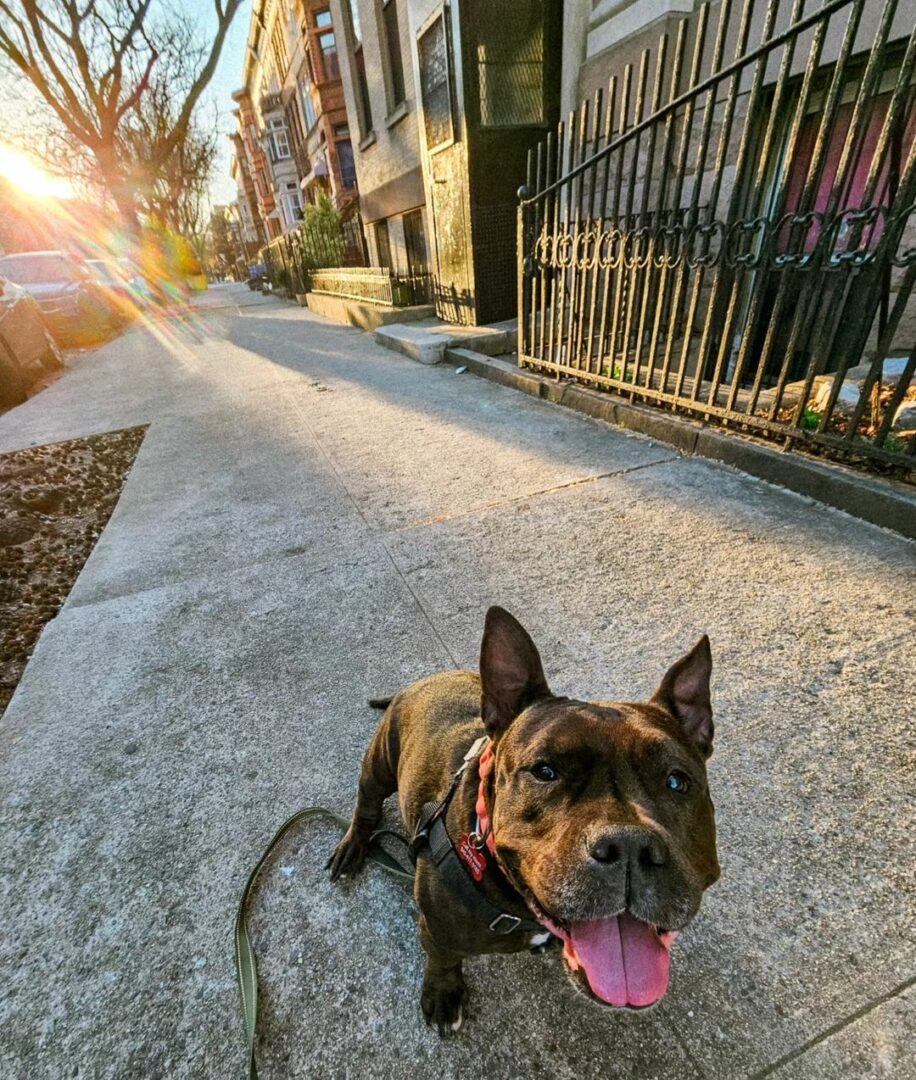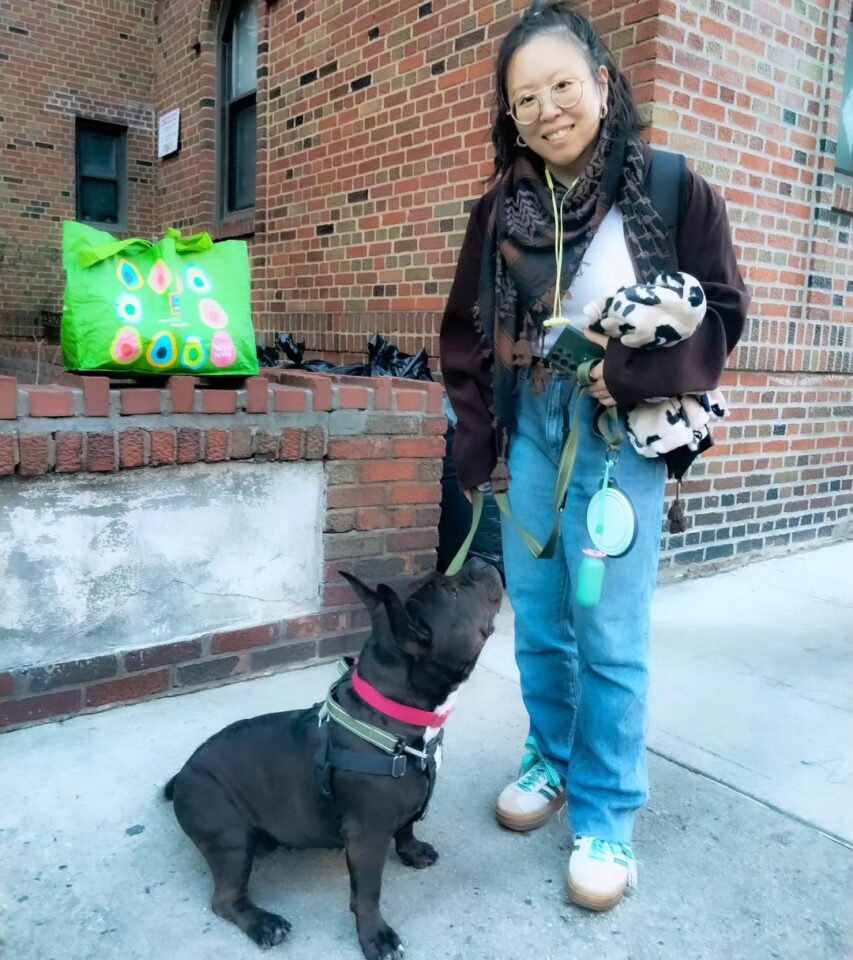Many canines go through a difficult time after they find themselves behind shelter walls.
While some shelter pups never lose hope of finding loving families, other dogs become stressed, and their health starts deteriorating.
The canine felt confused and sorrowful, wondering why she suddenly lost the only place she called home.
The Pup’s Shelter Life

She was having a hard time getting used to shelter life. The doggo missed her owner. She kept expecting to see their beloved faces appearing around the corner.
The pooch was going through a lot of stress, which took a toll on her health.
“Brooklyn was stressed in the shelter and had allergic dermatitis, causing her to lose patches of hair,” Katy Hansen, the marketing and communications director at ACC told Newsweek.
Wishing to help her relieve her anxiety at the overcrowded shelter, her shelter friends moved Brooklyn to the manager’s office.
Luckily, Dr Jay Kuhlman, a board member at ACC, gave Brooklyn specialized treatment for her dermatitis. At last, the pup started her road to recovery.
Brooklyn won the hearts of her shelter friends. They were rooting for her to recover and find her happiness.
Love Helps Her Heal

The ACC Foster Team succeeded in placing her in a loving foster home where she could heal and relax.
Her foster family dedicated themselves to her care, showering Brooklyn with affection and positive affirmations.
Away from the noisy shelter environment, the pup started recovering. Feeling safe and loved, Brooklyn finally revealed her wonderful personality.
Thanks to the loving foster parents who opened their hearts to her, she forgot about her past life and looked forward to her new future.
Brooklyn started searching for a forever home.
Savoring All Her Mom’s Love

A wonderful woman named Sayra noticed the adorable Brooklyn, and the pup immediately captivated her heart. She applied for her adoption.
When the shelter staff heard that the delightful pup was leaving the shelter, they could hardly contain their emotions.
They were ecstatic because their lovely girl finally found her place under the sun.
Brooklyn’s eyes were full of joy and pride after she met her forever mom.
Her sweet face was a picture of happiness. She couldn’t wait to begin a new life filled with the joy that she dreamed of while being in the shelter.
The shelter posted a video about Brooklyn on their TikTok account. They included an update about the dog’s life that her mom shared with them.
“It’s hard to believe we have only been together for two weeks. From the first night, she has slept soundly throughout the night,” Yeobo’s mom, Sayra said.

The pup moved into her new forever home in Brooklyn and changed her name to Yeobo, which is a Korean term for endearment.
The sweet canine and her mom formed a strong bond, and they enjoyed spending their time together.

She and her forever mom adore each other, and they feel over the moon because they found each other.
If you’re like most dog owners, figuring out how much food to give your furry friend can sometimes feel like a guessing game. Finding the right balance between keeping them healthy and satisfied can be a bit tricky. You want to ensure they’re getting all the nutrients they need without overfeeding them.
As a seasoned dog trainer, I’ve seen firsthand the importance of getting your pup’s diet just right. It’s not just about the quantity but also the quality of the food you provide. From portion sizes to understanding your dog’s unique needs, there are a few key factors to consider when it comes to feeding your canine companion. In this article, we’ll break down some essential tips to help you navigate the world of doggy dining with confidence.
Understanding Your Dog’s Nutritional Needs
Feeding your furry friend the right amount of food is crucial for keeping them healthy and happy. Understanding your dog’s nutritional needs is key to providing them with a balanced diet. Here are some essential points to consider:
- Dog’s Size and Age: Your dog’s size and age play a significant role in determining their nutritional requirements. Puppies, for example, need more calories to support their growth, while senior dogs may require special diets tailored to their age-related needs.
- Activity Level: Just like humans, dogs’ activity levels vary. An active dog will need more calories than a sedentary one. Consider your dog’s exercise routine when deciding on their food portions.
- Breed Specifics: Different dog breeds have different nutritional needs. Larger breeds may require food formulated for their size to support healthy bone growth, while smaller breeds may need smaller kibble for easier chewing.
- Food Quality: Opt for high-quality dog food that is nutritionally balanced. Look for labels that indicate the food meets the AAFCO standards to ensure your dog gets the essential nutrients they need.
- Consult Your Vet: If you’re unsure about how much to feed your dog, consult your veterinarian. They can provide tailored advice based on your dog’s specific needs, ensuring they get the right nutrition for their health and well-being.
Understanding and meeting your dog’s nutritional needs is essential to keeping them healthy and happy. By considering factors like size, age, activity level, breed, and food quality, you can provide your dog with a diet that supports their overall health and vitality.
Calculating Your Dog’s Daily Caloric Intake
When it comes to determining how much food to feed your dog, understanding their daily caloric intake is essential. You can calculate this by considering factors like your dog’s size, age, activity level, breed, and the type of food they eat.
Factors to Consider
- Size: Larger dogs generally require more calories than smaller ones. For example, a larger breed like a Great Dane will need more food compared to a smaller breed like a Chihuahua.
- Age: Puppies have different nutritional needs than adult dogs. Younger puppies need more frequent meals to support their growth and development.
- Activity Level: Active dogs and working breeds may need more calories to sustain their energy levels compared to less active or senior dogs.
- Breed Specifics: Some breeds may have specific dietary requirements based on their energy levels and predisposition to certain health conditions.
- Food Quality: High-quality dog food provides essential nutrients with fewer fillers, ensuring your dog gets the necessary nutrients without excess calories.
Calculating Calories
To determine your dog’s daily caloric intake, you can use a formula based on their weight, activity level, and life stage. The equation typically involves multiplying your dog’s weight by a specific factor based on their activity level.
Consulting a Veterinarian
For precise guidance tailored to your dog’s individual needs, always consult with your veterinarian. They can provide personalized recommendations based on your dog’s health, lifestyle, and any special dietary requirements.
By understanding your dog’s daily caloric intake and considering these factors, you can ensure your furry friend receives the right amount of food to keep them healthy, happy, and full of energy.
Ensure your dog’s well-being by providing them with a balanced diet that meets their nutritional needs. Consulting your veterinarian will help you make informed decisions about your dog’s diet to support their overall health and happiness.
Choosing the Right Type of Food for Your Dog
When it comes to choosing the right food for your dog, there are a few key factors to consider to ensure they get the nutrition they need. Here’s what you should keep in mind:
1. Nutritional Balance:
Ensure the food you choose provides a balanced diet with the right mix of proteins, fats, carbohydrates, vitamins, and minerals. This balance is essential for your dog’s overall health and well-being.
2. Life Stage and Health Needs:
Consider your dog’s age, size, and any specific health requirements they may have. Puppies, adult dogs, and seniors have different nutritional needs, so choose food that caters to their life stage.
3. Activity Level:
The amount of exercise your dog gets influences their calorie requirements. Active dogs need more calories than sedentary ones. Pick a food that aligns with your dog’s activity level to maintain their energy levels.
4. Breed Specifics:
Certain breeds may have unique dietary needs. Large breeds, for example, may benefit from food designed for their size to support joint health. Factor in any breed-specific requirements when selecting their food.
5. Quality of Ingredients:
Opt for high-quality ingredients in your dog’s food. Look for real meats, whole grains, and natural sources of essential nutrients. Avoid foods with fillers, artificial flavors, and preservatives.
6. Consulting a Veterinarian:
For personalized advice on choosing the best food for your dog, consult your veterinarian. They can provide insights based on your dog’s individual needs, helping you make the right choice for their diet.
By considering these factors and selecting the right type of food for your dog, you can ensure they stay happy, healthy, and full of energy. Remember, a well-balanced diet is key to supporting your furry friend’s overall well-being.
Developing a Feeding Schedule for Your Dog
When it comes to establishing a feeding schedule for your furry companion, consistency is key. Here’s how you can set up a routine that works for you and your dog:
1. Portion Control:
Divide your dog’s daily food intake into 2-3 meals spread throughout the day to prevent overeating and maintain energy levels.
2. Consult Your Veterinarian:
Seek advice from your vet to determine the ideal portion size based on your dog’s specific needs, considering factors like age, weight, activity level, and any health conditions.
3. Stick to a Routine:
Feed your dog at the same times each day to establish a routine that helps with digestion and prevents unpredictable behavior.
4. Choose the Right Food:
Select a high-quality, balanced diet that meets your dog’s nutritional requirements and suits their life stage, whether it’s puppy, adult, or senior food.
5. Monitor Your Dog’s Weight:
Regularly check your dog’s weight and adjust their food portions accordingly to ensure they maintain a healthy weight.
6. Avoid Free Feeding:
Avoid leaving food out all day for your dog to graze on, as it can lead to weight gain and disrupt their eating habits.
By following these steps and tailoring the feeding schedule to your dog’s specific needs, you’ll help them stay healthy, happy, and satisfied with their meals.
Special Considerations for Puppies, Seniors, and Dogs with Health Issues
Puppies
- Puppies need more frequent meals compared to adult dogs.
- Feed them several small meals throughout the day.
- Consult your vet for specific feeding guidelines based on your puppy’s breed and size.
Seniors
- Senior dogs may require fewer calories due to lower activity levels.
- Choose food formulated for older dogs to meet their nutritional needs.
- Your vet can recommend the right feeding schedule and portion sizes for your senior dog.
- Dogs with health issues may have special dietary requirements.
- Follow your vet’s advice on specific foods to address health issues.
- Monitor their weight and adjust their food intake accordingly.
By considering the unique needs of puppies, seniors, and dogs with health issues, you can ensure they receive the appropriate amount of food to maintain their health and well-being. Consulting your vet for personalized guidance is crucial in providing the best nutrition for your furry companion.
Conclusion
Feeding your furry friend the right amount of food is crucial for their health and happiness. Remember to consider their life stage, weight, and any health issues when determining their diet. By establishing a feeding schedule, controlling portions, and choosing quality food, you can ensure they get the nutrition they need. Don’t forget to monitor their weight and consult your vet for personalized advice. Whether you have a playful puppy, a wise senior, or a dog with special needs, tailoring their diet to meet their specific requirements is key. With proper care and attention to their dietary needs, you can keep your canine companion healthy and thriving.
Frequently Asked Questions
1. How can I determine the right amount of food for my dog?
Consulting with a veterinarian is crucial for determining the correct amount of food based on your dog’s specific needs.
2. What should I consider when developing a feeding schedule for my dog?
Consider factors like age, size, activity level, health condition, and feeding preferences when creating a feeding schedule for your dog.
3. How do I monitor my dog’s weight to ensure proper nutrition?
Regularly monitor your dog’s weight by using a scale and adjusting their diet accordingly to maintain a healthy weight.
4. What food should I choose based on my dog’s life stage?
Choose dog food tailored to your dog’s life stage (puppy, adult, senior) to ensure they receive appropriate nutrition for their age.
5. How can I avoid free feeding my dog?
Create a feeding schedule with set mealtimes and portion control to prevent free feeding and maintain a balanced diet for your dog.
6. What considerations are important for feeding puppies?
Puppies require more frequent meals, adjusted calorie intake, and specialized diets for proper growth and development.
7. What should I consider for feeding senior dogs?
Senior dogs may need adjusted calorie levels, softer food options, and supplements for joint health and overall well-being.
8. How do I choose the right food for a dog with health issues?
Consult your vet for recommendations on specialized diets, feeding frequencies, calorie adjustments, and supplements tailored to your dog’s specific health needs.
[no_toc]

Hey there, I’m Janet Brooks, a dog-loving student from California. I’m all about helping pups in need, especially those without homes. Me and my awesome friends work together to give shelter and love to stray dogs. Oh, and I also write blogs about dogs to share helpful info.